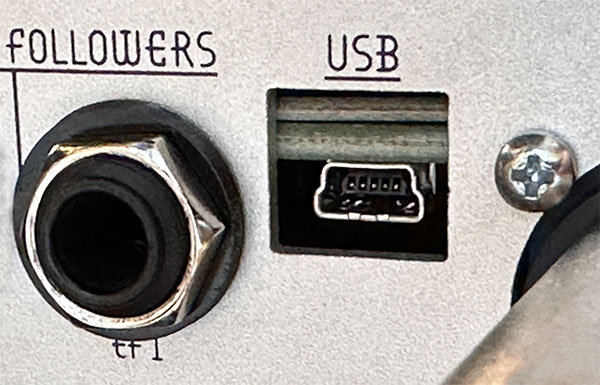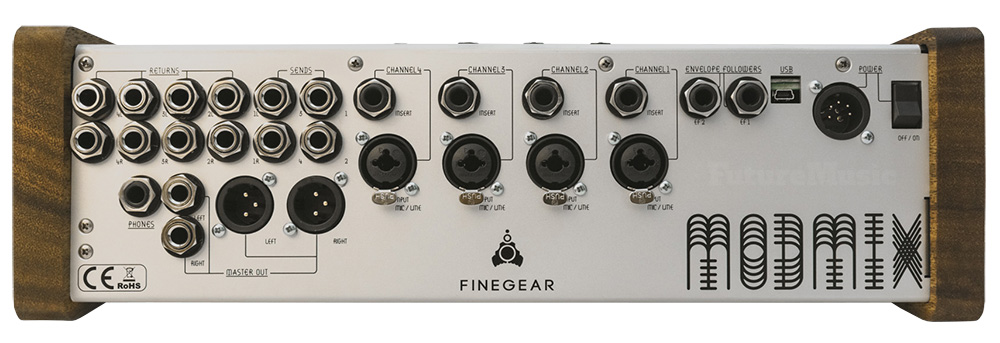Finegear’s Modmix is a dynamic four-channel, rotary mixing console developed for musicians who are interested in experimenting with fascinating routing capabilities and no-input mixing. In essence, Finegear’s goal was to turn the Modmix into an instrument that pushes a musician into new creative realms.
While there are absolutely no shortage of mixers on the market that can perform a wide variety of tasks, from the new Mackie Onyx series with onboard effects, recording and even Bluetooth, to the more conventional, such as the SSL BigSIX, there is really nothing that can compare to the Modmix’s features. We had four different reviewers evaluate the Modmix; their comments in quotes below.


For a limited time only! Up to 80% off all Waves Bundles. PLUS click the banner above or the Go button for an additional 10%! This is Waves best deal yet! Get yours today before this special ends! Go!
Each channel has a three-band EQ, four Aux Sends, an Insert and a XLR/1/4″ Combo jack with phantom power. Each one of the Aux Sends has a stereo Return, which in essence can be employed as four extra stereo inputs, but can also be routed back into the same channel to create overtones, distortion and feedback. The four Aux sends can also be sent to external effects units or signal processors, which should certainly appeal to electronic musicians, progressive rock or shoegaze artists. “I can’t think of any other four channel mixer on the market that can sound this thick,” observed one of our reviewers who specializes in ambient music.
The Modmix is really a synth disguised as a mixer, or a mixer disguised as a synth, depending on how you look at it…
Each one of the four channels has four CV Volume Sends linked to the Aux’s, a CV Volume Input and a CV Pan Input, which “should put a smile on the face of the Eurorack crowd.” Where things get really interesting is the Modmix contains two LFOs with two outputs, an input and +/- amounts (inverted). The LFOs can be synced to the USB MIDI input or can be free flowing with controls for Speed and Symmetry (Waveform width), plus the selection of three waveforms, sine, triangle and square.
If that wasn’t enough, the Modmix also features two Envelope Followers with Attack (5-60ms), Decay (20-500ms) and Sensitivity, as well as a Low Pass and High Pass filters. The Hi-Cut and Lo-Cut allow the user to set the cutoff frequency at the input of the Envelope Follower. There are two 1/4″ audio inputs on the back of the Modmix to feed the two Envelope Followers. However, if there are no connections, the connections are normalized so that Envelope Follower 1 is pre-patched to the signal from Channel 1 and the Envelope Follower 2 will be fed the signal from Channel 2.
All of this non-mixer action begs the question, who exactly is the target market for the Modmix? The obvious answer is the experimental electronic musician, or what one of the reviewers affectionally called the “Bloops and Bleeps” crowd, who are into creating wild soundscapes that they can modulate in realtime. As a “no-input” mixer, or a unit that can generate its own sounds without any incoming sound sources, and its imaginative ability to route its signal back into itself, the Modmix is well suited for textured drones, “phlegmy globs of distortion” and mayhem that can easily trash your monitors without remorse (a limiter is certainly recommended). However, one should not dismiss the performance capabilities of the Modmix.
The Modmix pleads to be touched. Its solid and tasty knobs are nicely ridged and are the perfect size, not too small and not too big. The mixer also graciously places them with plenty of space so you can get your fingers around each knob without barging into its neighbor. Signal feedback is depicted with small green LEDs that showcase the Signal strength with brightness. There are dedicated clipping LEDs on the four main channels, which is something you’ll see a lot of with the Modmix. The LEDs are mandatory on a mixer like this, but two of our reviewers would have also liked a five-segment meter on each one of the channels as well instead of a single LED and clipping indicator. The main output is showcased in “delicious UV meters that dance to your music.”

The Prototype-y USB Cutout Won’t Win Any Beauty Pageants
Where the Modmix stumbles is in the MIDI implementation. Instead of having DIN MIDI In/Out connections, or even minijack 3.5mm connections, Finegear chose to use a USB-2 Mini connection glued in a slot that looks like it was originally designed for the square USB-B interface. Not only isn’t it attractive on a mixer that clearly wants to tout its aesthetic, but also a miss since an analog mixer of this caliber is truly meant to interface with hardware and not a computer.
“The MIDI interface is the only thing that isn’t well thought out on the Modmix,” observed one reviewer. “I’ve tried to come up with a explanation for this decision, aside from firmware updates, but really can’t think of a reason why analog MIDI I/O was excluded. A bad miss.”
“The MIDI interface is the only thing that isn’t well thought out on the Modmix”
The other curious decision was to have a toggle on each of the four channels either routing the signal to the Phones or the Master, but not both. According to the manual, you can open up the Modmix and change this setting, voiding the warranty, but our reviewers thought that “this should have been the other way around.”
But let’s get back to the Modmix’s feedback circuit and the synth within. As mentioned above, the Modmix is really a synth disguised as a mixer, or a mixer disguised as a synth, depending on how you look at it. In this regard, what you can achieve with the Modmix is unlike any other mixer on the market. Cristian Kreindler, the founder of Finegear and the Modmix’s inventor, has a special affinity for filthy sounds. This is evidenced by not only Modmix’s “special blend of gnarly,” but also Finegear’s other products, the Dirt Magnet and the Dust Collector. Kreindler likes to play in the mud and he thinks you will too.
To this end, the Modmix’s LFOs, EVs and feedback circuit can “go hobo very fast.” But when you start feeding back all four Aux sends together “the sound becomes the unwashed massive.” Huge “waves of bedlam” make you feel like you’re “playing in a landfill – in a good way.” Beware. The sound can get out of hand very quickly, resulting in crazy clipping and distortion that will put “your favorite speakers six feet under.” However, once you get a feel for what the Modmix’s limits, you can ride the craze into new realms.
MIDI Designer Is Now Free!
MIDI Designer Pro X is now free to download! MIDI Designer Pro X is a professional-grade MIDI controller platform for iPhone, iPad and Mac. User-contributed layouts let you control everything from Ableton to Yamaha out of the box. Go beyond hardware and express your musical vision. Check out out now!

Finegear Modmix Specifications:
- Current draw: ? 1 A for each rail (+12 V, -12 V)
- Impedance: Input – Unbalanced: 10k ? / Balanced: 20k ?
- Effects send out: Unbalanced: 40 ? / Balanced: 80 ?
- Effects return: Unbalanced: 22 k ? / Balanced: 44 k ?
- Output: Unbalanced: 40 ? / Balanced: 80 ?
- Phones: 20 ?
- SNR: -95 dB
- Crosstalk: -80 dB
- Input amp gain: Microphone: -? to 40 dB
- Line: -? to 20 dB
- Aux Send gains: -? to 10 dB
- Equalizer: High (60 Hz): ±10 dB / Mid (300 Hz -1.9 kHz): ±10 dB / Low (12 kHz): ±10 dB
- Volume amp gain: -? to 6 dB
- Frequency response: Master amp gain: -? to 10 dB
- Phones amp gain: -? to 15 dB
- Stereo returns amp gain: -? to 10 dB
- Dimensions: 43 x 38 x 12 cm
- Weight: 5 kg
- Power Supply: Voltage input: 220/110 V
- Voltage output: 12 V, -12 V, 48 V
- Maximum current draw: 1 A on each rail (+12 V, -12 V)
- Signal Path Diagram
We do have to mention that the Modmix is noisier than many other mixers available. Considering the Modmix’s features, superpowers and focus, this is to be expected to some degree. The Modmix has a lot of gain and with the unit’s unique architecture, this may be something that’s just inherent to the design. While many of its users won’t be bothered as they get into the “bowels of the feedback circuit,” others who are “looking for a very low noise floor may be disappointed.” In fact, “a noticeable hiss” can be heard when employing the LFOs, EVs and Aux Sends.

The easiest way for electronic musicians to get their music onto Spotify, Apple Music, iTunes, Amazon Music, Tidal, Instagram, Facebook, TikTok, Pandora, Twitch & much more! Click the banner above or the Go Button to save 7% off of your signup! Go!
Conclusion
Currently at €1500, the Modmix is not cheap for a four-channel mixer. However, it’s much, much more than a simple mixer and for experimental electronic musicians, this could be the one bit of kit that takes your entire music making and live performance into the next dimension — especially if “you define a ‘good time’ as spending hours in your studio exploring audio’s outer rim.” We did ding the Modmix for its MIDI implementation, noise floor and USB prototype build, but the innovative concept and its ability to provide hours of experimental pleasure, makes the Modmix a winner. Highly Recommended.
Finegear Modmix Rating: 90%
Cheers:
+ Innovative
+ Lots Of Fun
+ Live Performance
+ Routing
+ No-Input Mixing
Jeers:
– No Analog MIDI I/O
– Noise
– Frankenstein USB Port

Finegear’s Modmix costs €1500.
The Future: The first order of business is getting the analog MIDI I/O sorted. Two DIN MIDI Input / Output ports need to be added as soon as possible. The USB cutout “gone wrong” should be an easily fix, but employ the USB-C interface. We haven’t seen much of the USB-B Mini since the Blackberry. The noise floor maybe something that’s simply baked into the unit, but if there’s a methodology to mitigate some of it, or add a simple gate that may alleviate some of the unwanted hiss. Adding filters on the four channels, and/or even the four Returns could create more nuanced mayhem.












